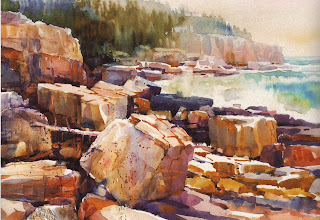For granite shoreline rocks, imagine a box with its 8 tips knocked off and softened by surf action. Imagine dipping a sugar cube into hot tea and quickly removing it-- voila, a square-ish lump! Next, trust that you can communicate all you need with only 3 values (aka, tones of gray)-- highlights (white or nearly white), midtones (light to middle gray), and shadows (dark gray to black).
You want to assign the lightest value-- white to the top surface of the "sugar cube" because that's where the sun's light is strongest. Don't worry at first if it's a dark rock, or stained & encrusted from sealife-- you can add that after you have modeled the rocks. If you like, you can mask these areas off with blue painter's tape from the hardward store. Rip it so that the tape looks more natural.
Now, confirm where the sun is coming from. You can very lightly draw a cartoon-ish light bulb onto your paper if you are new to this--erase later, of course! On the side of the rock opposite the lightbulb, add a mid-tone wash of a warm, natural pigmented paint, such as yellow ochre. Use a "flat" brush to do this-- and rather than just filling in the area, design an irregular shape to fit into the side of the rock. Add a smaller abstract shape on top when its dry with a warm blue such as Cobalt or Pthalo/Winsor Red shade.
Finally, give weight and shadow to the rocks by painting a dark, calligraphic shadow at the base of each rock and its intersection with other rocks. Do not outline the rock all the way around, no matter what! Less is more. Use a raw umber full strength... add variety into this shadow by mixing in a little Pthalo blue, black and Burnt Sienna from time to time.
Perspective is also very important portraying rocks. At the Tesselated Rocks National Park in Tasmania, columnar basalt has been eroded by salt crystals and water action into "loaves" (which are lumpy like sugar cubes) and "pans," which act as shallow rectangular bowls at the edge of the Tasman Sea.
How amazingly literal can this perspective be??? If you need to clarify the light & dark tones even more, remember that you can always photocopy/Photoshop it into a high-con black & white image.
Note how I have simplified the shapes and shading in my journal entry, based on this photo. How embarrassing that the drawing doesn't look like my husband-- he looks like the guy in Glee, which I had just watched before drawing the image!! (It happens...)
Study the work of master teacher & watercolorist Carlton Plummer AWS for his amazing simplicity and facility with painting "sugar cube" rock forms. His paintings of the Maine coast will inspire you for years to come. See a fabulous example below from Plummer's book Create Dramatic Coastal Scenes in Watercolor (ISBN 1-929834-37-3).





No comments:
Post a Comment